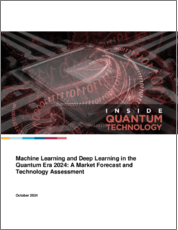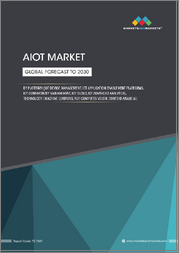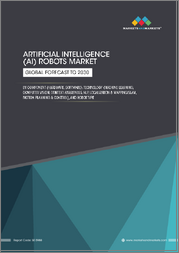
|
시장보고서
상품코드
1536238
양자 시대의 머신러닝과 딥러닝(2024년) : 시장 예측 및 기술 평가Machine Learning and Deep Learning in the Quantum Era 2024: A Market Forecast and Technology Assessment |
||||||
머신러닝(ML)은 AI 시장에서 가장 성숙한 분야 중 하나로, 1950년대부터 시작된 머신러닝(ML)은 기계가 특정 작업을 수행하도록 가르치고 패턴을 식별하여 정확한 결과를 제공하도록 가르칩니다. 양자 컴퓨터의 등장은 양자 컴퓨팅의 힘을 ML에 어떻게 적용할 수 있는지에 대한 추측을 불러일으켰습니다. 양자 머신러닝(QML)은 실행 시간 단축, 학습 효율 향상, 학습 능력 향상 측면에서 기존 ML을 개선할 수 있다는 공감대가 형성되고 있습니다.
이 보고서는 양자 시대의 머신러닝과 딥러닝에 대해 조사했으며, QML의 비즈니스 기회와 용도를 파악하며, 이미 등장하기 시작한 것과 앞으로 등장할 것으로 예상되는 것들을 소개합니다. 또한, QML 기술이 어떻게 진화할 것인지에 대해 논의하고, 이 분야에서 활동하는 25개 주요 기업 및 연구기관프로파일과 함께 QML 수익의 10년 예측을 제시합니다. 또한, 양자 머신러닝의 비용과 미숙함, QML에 최적화된 알고리즘의 필요성, QML의 최적 도입 방법에 대한 더 깊은 이해 등 QML의 성장을 저해하는 요인에 대해서도 분석합니다.
목차
주요 요약
제1장 양자 머신러닝 가능성 개요
- 이 보고서의 목적
- QML : 생각할 수 있는 장점
- QML : 생각할 수 있는 단점
- 본 보고서 계획
- 정보 출처
- 예측 조사 방법
제2장 QML 알고리즘과 소프트웨어의 가능성
- 머신러닝과 출현
- 머신러닝의 유형
- 양자 딥러닝과 양자 뉴럴 네트워크(neural network)
- 양자 박크프로파게이션 부상
- QML에서의 트랜스포머
- QDL에서의 퍼셉트론
- ML와 데이터 세트에 관한 몇개의 주의 사항
- 양자 알고리즘 : 개발과 기회
- 대규모 데이터 세트 취급 : 양자의주성분 분석
- Grover's Algorithm의 용도
- 최적화 기술 개선
- QML-over-the-Cloud와 QML-as-a-Service
- QML 보안과 프라이버시
- QML 소프트웨어 기업
- Dassault/Abaqus
- GenMat
- Microsoft
- OTI Lumionics
- PennyLane/Xanadu
- ProteinQure
- 1Qbit and Good Chemistry
- QC Ware
- QpiAI
- Quantistry
제3장 QML 하드웨어 고려사항
- 양자 어닐링
- NISQ 컴퓨터와 QML
- NISQ를 넘어선 QML
- QML를 사용한 양자 하드웨어 제조와 최적화
- 머신러닝과 QRNG에 관한 메모
제4장 QML 응용
- QML 기회 서론
- 금융 및 은행에서의 QML 응용
- 헬스케어 및 생명과학
- 제조업에서의 QML 응용
- 기타에서의 QML 응용
제5장 QML의 10개년ㅁ 예측
LSH 24.11.27Machine learning (ML) is one of the most mature segments of the AI market - it dates to the 1950s. ML teaches machines to perform specific tasks and provide accurate results by identifying patterns. The advent of quantum computers has led to speculations on how the power of quantum computing can be applied to ML. A consensus is building that Quantum Machine Learning (QML) can improve classical ML in terms of faster run times, increased learning efficiencies and boosted learning capacity.
QML exhibits several emerging trends:
- Using quantum computers to solve traditional ML problems.
- Developing improved ML algorithms better suited to QML.
- Investigating new ways of delivering QML, especially over a cloud.
- Using classical ML to optimize quantum hardware operations, control systems, and user interfaces.
In this report, IQT Research identifies QML opportunities and applications already beginning to appear and those that we believe will emerge in the future. We also discuss how QML technology will evolve and include ten-year forecasts of QML revenues, along with profiles of 25 profiles of leading firms and research institutes active in the field. The report also analyzes the factors retarding the growth of QML such as the cost and immaturity of quantum machine learning, the need for QML-optimized algorithms and a deeper understanding of how QML is best deployed.
Table of Contents
Executive Summary
- E.1. Factors Driving the Quantum Machine Learning Market
- E.2. Opportunities in Algorithms and Software for QML
- E.2.1. Translating ML into QML: The First Phase of QML
- E.2.2. New Algorithms and Products: The Second Phase of QML
- E.3. Thoughts on Deep Learning
- E.4. Advantages of QML
- E.4.1. Improved Optimization and Generalization
- E.4.2. QML and Quantum Advantage
- E.5. The Disadvantages of QML
- E.5.1. High Cost of QCs
- E.5.2. Early Stage of Technology
- E.5.3. The Workforce Problem
- E.6. QML Roadmap and Forecasts
Chapter One: A Summary of Quantum Machine Learning Opportunities
- 1.1. Objective of this Report
- 1.2. QML: Possible Advantages
- 1.2.1. Training Advantages and Opportunities
- 1.2.2. Quantum Advantage and ML
- 1.2.3. Improved Accuracy
- 1.3. QML: Possible Disadvantages
- 1.3.1. Training Challenges
- 1.3.2. Uncertainty Regarding Quantum Advantage
- 1.3.3. Quantum Memory Issues
- 1.3.4. Comparisons of the Prospects and Challenges of QML at the Present Time
- 1.4. Plan of this Report
- 1.5. Information Sources
- 1.6. Forecasting Methodology
Chapter Two: Opportunities in QML Algorithms and Software
- 2.1. Machine Learning and its Emergence
- 2.2. Types of Machine Learning
- 2.3. Quantum Deep Learning and Quantum Neural Networks
- 2.3.1. Quantum Deep Learning (a.k.a. Deep Quantum Learning)
- 2.3.2. Training Quantum Neural Networks
- 2.3.3. Possible Applications for Quantum Neural Networks
- 2.3.4. Types of Neural Networks
- 2.3.5. Quantum Generative Adversarial Networks
- 2.4. The Rise of Quantum Backpropagation
- 2.5. Transformers in QML
- 2.6. Perceptrons in QDL
- 2.7. Some Notes on ML and Datasets
- 2.8. Quantum Algorithms: Development and Opportunities
- 2.8.1. Quantum Encoding
- 2.8.2. Example of other QML Algorithms
- 2.8.3. Hybrid Quantum/Classical ML and the Path to True QML
- 2.9. Handling Larger Data Sets: Quantum Principal Component Analysis
- 2.9.1. Dimensionality Reduction: Quantum Principal Component Analysis
- 2.10. Uses of Grover's Algorithm
- 2.11. Improved Optimization Techniques
- 2.12. QML-over-the-Cloud and QML-as-a-Service
- 2.13. Security and Privacy in QML
- 2.13.1. Growing QML Vulnerabilities During the Training and Inference Phases
- 2.13.2. Security on QML Clouds and QML-as-a-Service
- 2.13.3. Security on QML Architecture
- 2.14. QML Software Companies
- 2.14.1. Dassault/Abaqus (United States)
- 2.14.2. GenMat (United States)
- 2.14.3. Google (United States)
- 2.14.4. Microsoft (United States)
- 2.14.5. OTI Lumionics
- 2.14.6. PennyLane/Xanadu (Canada)
- 2.14.7. ProteinQure (Canada)
- 2.14.8. 1Qbit and Good Chemistry (Canada)
- 2.14.9. QC Ware (United States)
- 2.14.10. QpiAI (India)
- 2.14.11. Quantistry (Germany)
Chapter Three: QML Hardware Considerations
- 3.1. Quantum Annealing
- 3.1.1. A Note on Boltzman Machines
- 3.1.2. D-Wave (Canada)
- 3.2. NISQ Computers and QML
- 3.2.1. Amazon/AWS (United States)
- 3.2.2. Atom Computing
- 3.2.3. Google AI (United States)
- 3.2.4. IBM (United States)
- 3.2.5. IonQ (United States)
- 3.2.6. Nordic Quantum Computing Group (Norway)
- 3.2.7. ORCA Computing (UK)
- 3.2.8. Oxford Quantum Circuits (United Kingdom)
- 3.2.9. Pasqal (France)
- 3.2.10. planqc (Germany)
- 3.2.11. QuEra (United States)
- 3.2.12. Quantinuum (United States)
- 3.2.13. Rigetti (United States)
- 3.2.14. Terra Quantum (Switzerland)
- 3.3. QML beyond NISQ
- 3.4. Fabricating and Optimizing Quantum Hardware Using QML
- 3.4.1. Mind Foundry (United Kingdom)
- 3.4.2. QuantrolOx (UK/Finland)
- 3.5. A Note on Machine Learning and QRNGs
Chapter Four: Applications for QML
- 4.1. Introduction to QML Opportunities
- 4.2. Financial and Banking Applications for QML
- 4.2.1. Adaptive Finance (Canada)
- 4.2.2. Qkrishi (India)
- 4.3. Healthcare and Life Sciences
- 4.3.1. Impact of Sensors as a Source of QML-based Diagnostic Data
- 4.3.2. QML and Personalized Medicine
- 4.3.3. Pharma and QML
- 4.3.4. Kuano (Lithuania)
- 4.3.5. QunaSys (Japan)
- 4.3.6. MentenAI (Canada)
- 4.4. Manufacturing Sector Applications for QML
- 4.5. Other Applications for QML
Chapter Five: Ten-Year Forecasts of QML
- 5.1. Background to Forecasts
- 5.1.1. Reasons to Doubt QML
- 5.2. Forecast of QML as Technology
- 5.3. Forecast of QML by Application
- About the Analyst
List of Exhibits
- Exhibit E-1: Ten-year Revenues from Quantum Machine Learning and Quantum Deep Learning ($ Millions)
- Exhibit 1-1: Variations on a QML Theme: The Six Segments of the Quantum Machine Language Market
- Exhibit 1-2: Pros and Cons of QML
- Exhibit 2-1: The Relationship Between AI, Machine Learning, Deep Learning and Quantum Computing
- Exhibit 2-2: Types of ML Learning
- Exhibit 2-3: Selected Neural Network Type/Algorithms
- Exhibit 2-4: ML Transformer Applications
- Exhibit 2-5: Characteristics of ML Data by Source
- Exhibit 2-6: Selected QML Encoding Schemes
- Exhibit 2-7: Other QML Algorithms of Importance
- Exhibit 4-1: Selected Applications for QML in Banking and Financial Services
- Exhibit 4-2: Other Potential Applications of QML
- Exhibit 5-1: Ten-year Revenues from Quantum Machine Learning and Quantum Deep Learning ($ Millions)
- Exhibit 5-2: Ten-year Revenues - QML/ QDL by Application ($ Millions)



















